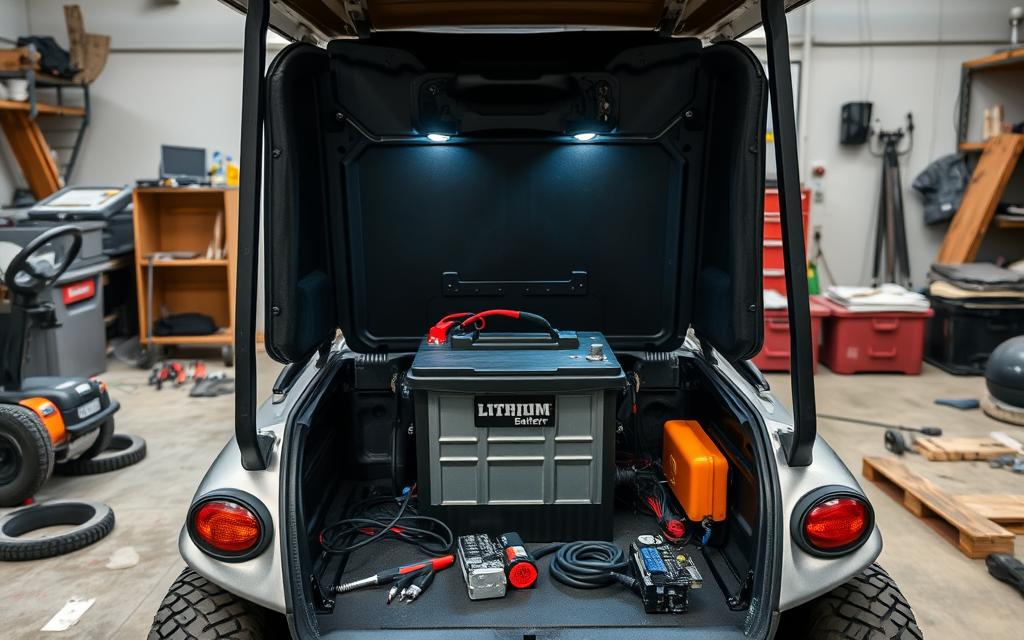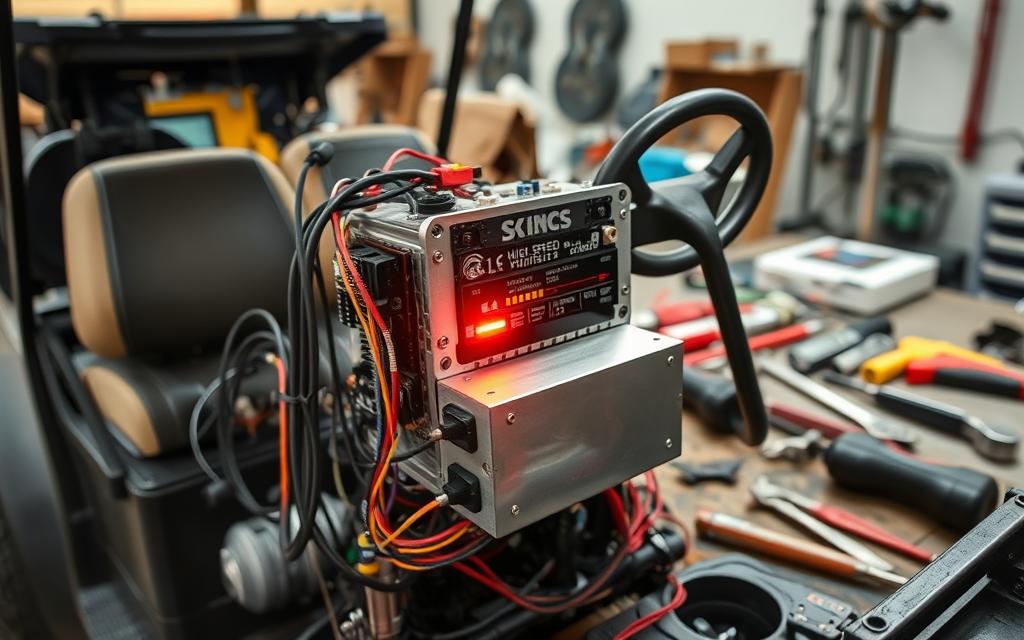I love golf and tinkering with things. Converting my golf cart to lithium-ion seemed like a great idea. It promised better performance and less upkeep. But, the journey was full of problems that made me very patient.
In this article, we’ll talk about the common Golf Cart Lithium Conversion Issues and Problems. We’ll cover battery charging problems, voltage issues, and more. My goal is to help you avoid these problems and make your golf cart lithium-powered.
Converting a golf cart to lithium batteries can offer many benefits, such as increased speed, longer battery life, and reduced maintenance. However, there are some common issues and problems that can arise during the conversion process:
- Voltage Compatibility Problems: Lithium batteries operate at different voltage levels compared to lead-acid batteries. Ensure that the motor controller and high-speed module are compatible with the voltage specifications of your lithium battery.
- Battery Management System (BMS) Conflicts: The BMS is crucial for managing the battery’s performance and safety. Conflicts or malfunctions in the BMS can lead to issues.
- Motor Overheating: Lithium batteries can cause the motor to overheat if not properly managed1. Ensure adequate cooling and ventilation.
- Wiring and Connection Problems: Incorrect wiring or loose connections can lead to performance issues or even safety hazards. Double-check all connections and follow the manufacturer’s guidelines.
- Initial Cost: The upfront cost of lithium batteries and conversion kits can be higher than traditional lead-acid batteries.
Key Takeaways
- Understand the common issues and problems associated with golf cart lithium conversion
- Learn how to address battery charging problems and voltage instabilities
- Discover strategies to mitigate overheating concerns and range anxiety
- Explore cost-effective solutions and weigh the trade-offs of lithium conversion
- Gain insights on navigating compatibility challenges and installation dilemmas
Decoding the Challenges of Golf Cart Lithium Conversion
Turning golf carts into lithium-ion batteries can be tricky. Golfers often face battery charging problems like long charging times. They might also deal with voltage drop issues, which can mess with the cart’s performance and range.
Battery Charging Conundrums
One big worry is making sure the cart’s charger can handle the new batteries. If it doesn’t, you might see a drop in battery life and performance. It’s key to watch the charging closely to avoid these problems.
Voltage Instabilities: A Common Hurdle
Another problem is voltage instability. This can make the cart’s power go up and down. To fix voltage drop issues, you need to check the cart’s electrical system and find ways to keep the voltage steady.
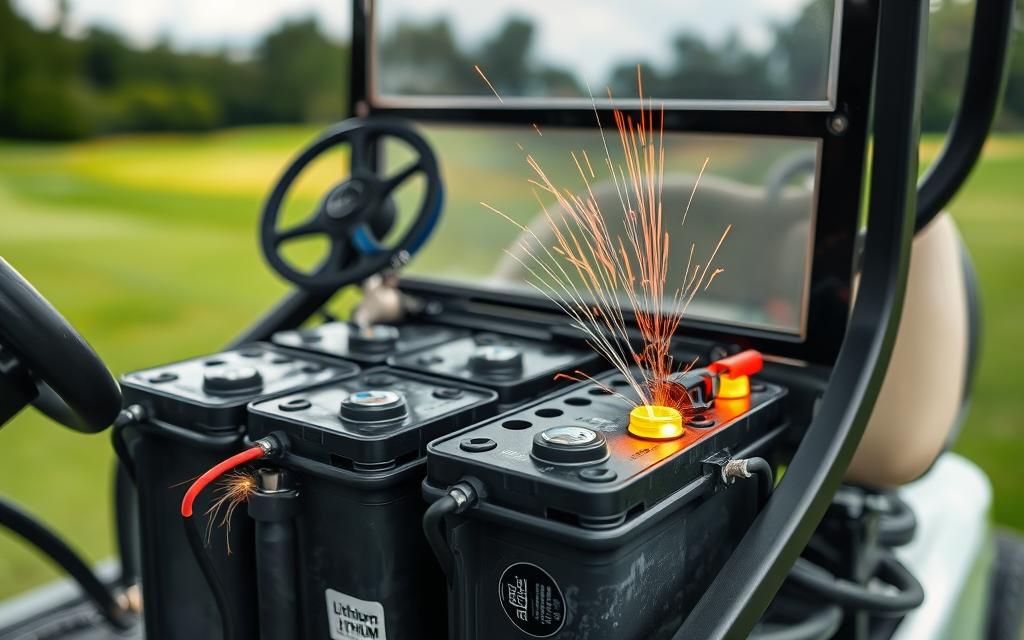
“Ensuring reliable and consistent power delivery is crucial for a seamless lithium-ion conversion, and addressing both battery charging and voltage stability concerns is essential for a successful transition.”
| Challenge | Impact | Potential Solution |
|---|---|---|
| Battery Charging Problems | Reduced battery life, decreased performance, safety risks | Monitoring charging process, ensuring full charge before use |
| Voltage Drop Issues | Fluctuating power output, decreased range and performance | Assessing electrical system, implementing mitigation strategies |
Unraveling Battery Management System Failures
The battery management system (BMS) is key in a lithium-ion golf cart conversion. It keeps the batteries safe, working well, and lasting long. But, BMS problems can happen during the conversion, causing big issues.
The BMS watches over the battery pack’s health. It checks things like voltage, current, temperature, and charge level. If it doesn’t work right, it can mess up the golf cart’s power system.
Common BMS Failures and their Consequences
- Voltage Imbalances: The BMS keeps each battery cell’s voltage even. If it fails, cells can wear out early, lose power, and be unsafe.
- Overcharging and Overdischarging: The BMS stops batteries from being charged too much or drained too much. If it doesn’t work, batteries can get damaged, last less time, and even catch fire.
- Temperature Monitoring Errors: The BMS checks the batteries’ temperature to keep them safe. If it can’t do this right, batteries can get too hot and catch fire or explode.
To avoid BMS problems, work with skilled pros during the conversion. They know how to set up the BMS right. Also, keep the BMS in check and watch it closely to keep your golf cart safe and reliable.
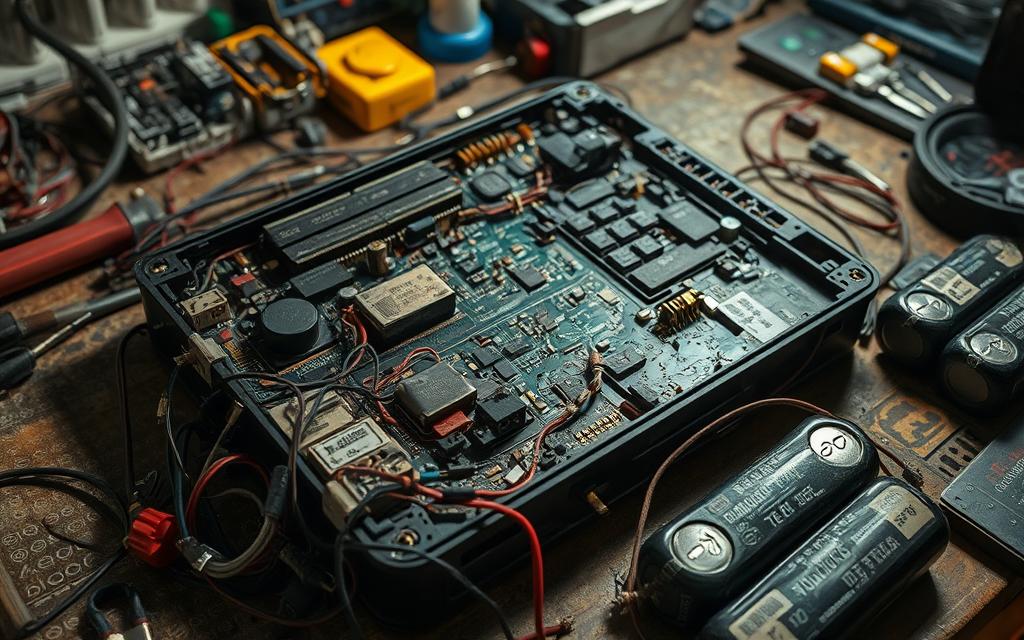
“Ensuring the BMS functions flawlessly is critical for the safe and reliable operation of a lithium-ion golf cart. Neglecting this component can have severe consequences.”
Overheating Concerns: A Sizzling Dilemma
Converting golf carts to lithium batteries is a big challenge. These batteries can get too hot and cause safety problems. It’s important to solve these overheating issues for a safe golf game.
Mitigating Thermal Risks
Lithium-ion batteries need careful handling to avoid overheating. Things like charging too much, driving fast, or sunlight can make them too hot. Golfers should watch their cart’s battery temperature closely and take steps to keep it cool.
Cooling Solutions for Lithium Batteries
To deal with overheating concerns, golfers can use cooling systems. Fans or liquid coolers can keep the battery at the right temperature. Also, making sure there’s good air flow around the battery helps keep it cool. These steps can make the battery last longer and keep golfing safe and fun.
| Cooling Solution | Effectiveness | Complexity | Cost |
|---|---|---|---|
| Fans | Moderate | Low | Low |
| Liquid-based Cooling | High | High | High |
| Improved Airflow | Moderate | Low | Low |

“Keeping your lithium-ion golf cart cool is not just a luxury, but a necessity for ensuring its long-term performance and safety.”
By tackling overheating concerns and using cooling solutions, golfers can make the most of their lithium golf carts. This ensures a fun and reliable golfing experience. With the right cooling methods, golfers can be sure their carts will perform well, no matter the conditions.
Range Anxiety: Overcoming the Fear of Running Out
Golf cart owners often worry about running out of power during a game. This fear is called “range anxiety.” It can be lessened by knowing how far your battery will go and how to use less power.
Learning about your lithium-ion golf cart’s range is key. Most modern batteries can power a full game and more. Knowing this can help you feel less worried about running out of power.
Smart ways to manage power can also help. For example, driving slower and using brakes to save energy. Also, check your battery often and plan when to charge.
- Minimizing acceleration and top speed
- Utilizing regenerative braking to recapture energy
- Monitoring battery levels and planning charging breaks
- Optimizing driving routes to minimize unnecessary energy consumption
Using these tips, you can play without worrying about running out of range anxiety.
Switching to lithium-ion technology is exciting. It’s a chance to learn and improve your golf cart experience. With the right approach, you can beat range anxiety and enjoy your lithium-ion golf cart.
Cost Considerations: Balancing Performance and Budget
Thinking about converting a golf cart to lithium-ion batteries? Cost is a big factor. The initial cost might seem high, but the long-term savings can be huge.
Upfront Investment Vs Long-Term Savings
The price of converting to lithium-ion batteries changes based on several things. These include the golf cart’s size, the parts needed, and the work involved. Costs usually fall between $2,000 and $5,000 or more.
But, this cost is worth it in the long run. Lithium-ion batteries last longer and need less maintenance than lead-acid ones. They also use less energy, which means lower charging costs. These savings can really add up, making the initial cost worth it.
| Cost Factor | Lead-Acid Batteries | Lithium-Ion Batteries |
|---|---|---|
| Upfront Cost | $1,000 – $2,000 | $2,000 – $5,000 |
| Lifespan | 2-3 years | 5-7 years |
| Maintenance Cost | $300 – $500 per year | $50 – $100 per year |
| Energy Efficiency | 70-80% | 90-95% |
For golfers thinking about lithium-ion conversion, it’s key to balance cost and benefits. The initial cost is higher, but the long-term savings are big. It’s a smart choice for better efficiency and lower maintenance costs.

Compatibility Challenges: Navigating the Maze
Adding lithium-ion batteries to a golf cart can be tricky. Golfers want to upgrade to the latest tech but face many challenges. They must make sure the batteries work well with the cart’s electrical system and other parts.
One big worry is making sure the batteries fit right. Golfers need to check the voltage, amperage, and charging needs of the new batteries. If these don’t match the cart’s, it can cause problems like charging issues or system failures.
| Compatibility Factor | Potential Issues | Recommended Solutions |
|---|---|---|
| Voltage Compatibility | Mismatch between battery and cart voltage can cause damage | Carefully select batteries with the correct voltage rating |
| Charging System | Incompatible chargers can lead to inefficient or incomplete charging | Upgrade to a lithium-ion compatible charger |
| Battery Management System (BMS) | Conflicts between the cart’s BMS and the new battery BMS can cause issues | Ensure seamless integration between the cart’s and battery’s BMS |
Golfers also need to think about how the batteries will fit physically. They must make sure the batteries fit well in the cart and don’t mess with other parts. This includes the steering and suspension.
Dealing with compatibility challenges needs careful attention and research. By knowing the possible problems and fixing them early, golfers can enjoy the benefits of lithium-ion batteries. They’ll have a smooth and reliable golfing experience.
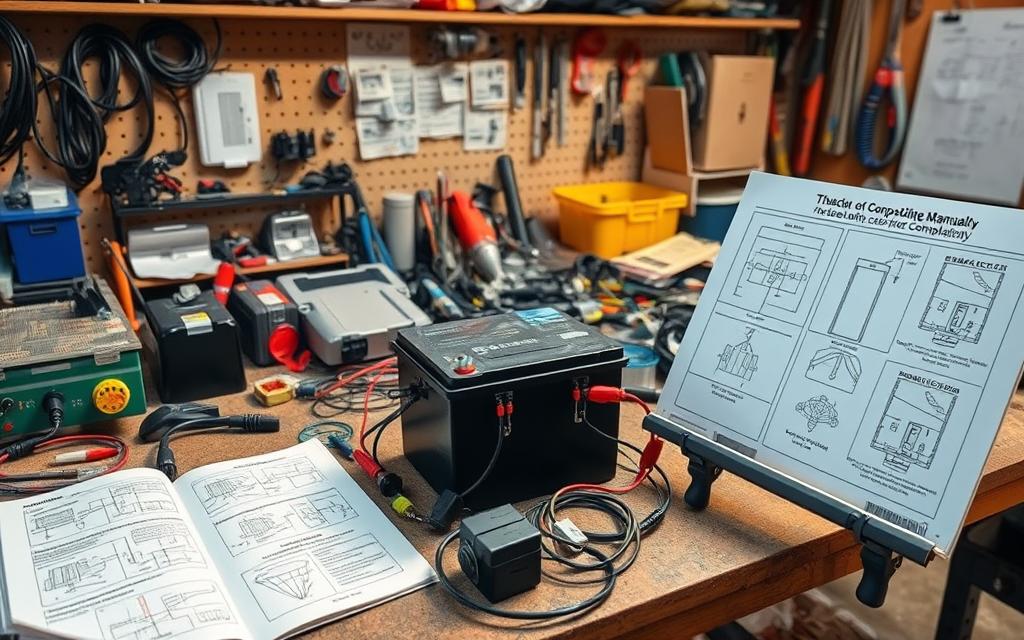
Installation Dilemmas: Smoothing the Transition
Turning a golf cart into a lithium-ion battery system is tricky. It can be hard for those new to this upgrade. But, getting help from a pro can make it easier.
Professional Assistance: A Wise Investment
Putting in lithium-ion batteries wrong can cause many problems. This includes voltage issues and safety risks. A skilled technician can avoid these installation difficulties.
They know how to wire the batteries right. They also make sure everything works well together. This means your golf cart will run smoothly.
Getting help also means you won’t have to deal with problems later. It saves time and money. Plus, it keeps your golfing fun without stress.
Even though it costs more to get a pro, it’s worth it. A good conversion means better performance and less trouble. It makes golfing more enjoyable.
Working with a pro helps you avoid installation difficulties. You get to enjoy the benefits of lithium-ion without the hassle.
Maintenance Requirements: Keeping Your Lithium-Ion Golf Cart Healthy
Switching to a lithium-ion golf cart has many benefits. But, it needs special care compared to old batteries. Knowing how to keep your lithium-ion cart in top shape is key for long-lasting use.
Lithium-ion cells need more care than old batteries. Here’s what you should do to keep your cart running well:
- Battery Monitoring: Check the battery levels often. Make sure they’re in the right range. Avoid overcharging or letting them drain too much.
- Charging Protocols: Follow the maker’s charging rules. Don’t charge too fast or leave it plugged in too long after it’s full.
- Storage Considerations: Store your cart at 50% charge during off-seasons. This keeps the batteries healthy for next year.
- Cooling System Maintenance: Keep the cooling system working right. Clean air vents and check fan work. This stops batteries from overheating.
By following these maintenance requirements, your lithium-ion cart will last longer. You’ll enjoy it for many years.
| Maintenance Task | Frequency | Importance |
|---|---|---|
| Battery Level Monitoring | Weekly | High |
| Charging Protocol Adherence | Every Use | High |
| Off-Season Storage | Seasonal | Medium |
| Cooling System Inspection | Monthly | High |
By sticking to these maintenance requirements, your lithium-ion golf cart will run great. It will last longer and give you many happy years of golfing.
Conclusion: Embracing the Future of Golf Cart Power
Exploring the challenges of switching golf carts to lithium-ion batteries shows promise. This change brings better performance, less upkeep, and a greener golfing experience. By understanding golf cart lithium, golfers can face issues like battery charging and range worries with ease.
The first cost might seem high, but the long-term gains are worth it. Lithium-ion batteries mean better efficiency, longer life, and lower costs. Also, tackling compatibility issues and getting help for installation ensures a smooth switch to this new tech.
Choosing lithium-ion batteries for golf carts is a big step towards a better golfing future. By being informed and ready, golfers can enjoy a cart that’s top-notch in performance, reliability, and care for the environment.
FAQ: Golf Cart Lithium Conversion Issues and Problems
How can I address battery charging problems with my lithium-ion golf cart?
Make sure your cart’s charging system works with lithium-ion batteries. It should charge efficiently. Check for voltage problems during charging.
What can I do about voltage drop issues in my lithium-ion golf cart?
Voltage drops can be a problem. Check your battery management system and wiring. Fixing these can help.
What are the maintenance requirements for a lithium-ion golf cart?
Maintenance is different for lithium-ion batteries. Watch battery levels and manage charging. Proper storage is also important. This keeps your cart running well.
What installation difficulties might I encounter with a lithium-ion golf cart conversion?
Installing batteries can be tricky. Getting help from a pro is a good idea. Wrong installation can cause problems.
What compatibility challenges might I face with a lithium-ion golf cart conversion?
Making sure your batteries fit your cart’s system is hard. You need to check voltage, wiring, and controller compatibility. This is key for a good conversion.
How do I balance the cost considerations of a lithium-ion golf cart conversion?
The cost is higher upfront. But, you save on maintenance and energy in the long run. Think about the benefits and costs carefully.
How can I overcome range anxiety with my lithium-ion golf cart?
Understand your battery’s range. Use power wisely. You might need a bigger battery for more range.
How can I address overheating concerns with my lithium-ion golf cart?
Overheating is a risk. Use cooling solutions like better ventilation. This keeps your cart safe and running well.
How can I prevent battery management system failures in my lithium-ion golf cart?
The BMS is key to battery health. Install and monitor it properly. This keeps your batteries safe and long-lasting.
Golf Cart Lithium Conversion Issues and Problems?
Converting a golf cart to lithium batteries can offer many benefits, such as increased speed, longer battery life, and reduced maintenance. However, there are some common issues and problems that can arise during the conversion process:
Voltage Compatibility Problems: Lithium batteries operate at different voltage levels compared to lead-acid batteries. Ensure that the motor controller and high-speed module are compatible with the voltage specifications of your lithium battery.
Battery Management System (BMS) Conflicts: The BMS is crucial for managing the battery’s performance and safety. Conflicts or malfunctions in the BMS can lead to issues.
Motor Overheating: Lithium batteries can cause the motor to overheat if not properly managed1. Ensure adequate cooling and ventilation.
Wiring and Connection Problems: Incorrect wiring or loose connections can lead to performance issues or even safety hazards. Double-check all connections and follow the manufacturer’s guidelines.
Initial Cost: The upfront cost of lithium batteries and conversion kits can be higher than traditional lead-acid batteries.
